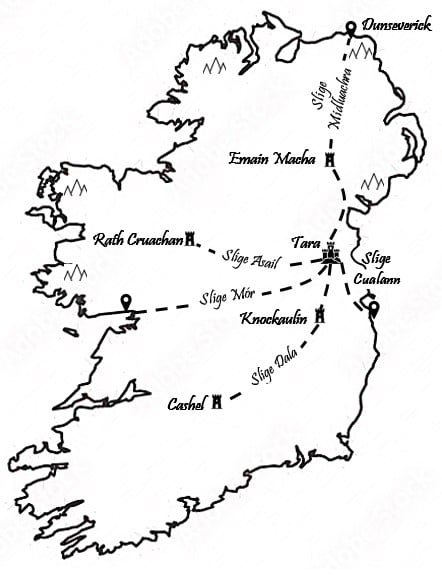Earlier this summer I watched the road outside my home slowly broken up and resurfaced. The many weeks of hard labour (granted they took far longer than needed), disruption and chaos created, and the army of trucks carrying materials, all got me thinking about how such roads were built and used in our ancient past. For, while there wasn’t a need for our great road network, travel and trade were as critical 2,000 years ago as they are today.

© Daniel Kirkpatrick
The 5 Highways
In the Lebor hUidre, or Book of the Dun Cow, there’s a passage which describes five separate roads that connected the political centre of Tara with the regions of Ireland.1 The Hill of Tara not only served as the inauguration seat of the High King, but also a religious centre due to its proximity to Newgrange, as an economic hub with the various fairs, banquets, and as a strategic centre given its location at the centre of the island. Like all capitols, it makes sense that Tara would have been a key hub for travel across the entire island.
North to Ulster
The first road to consider is that leading north, up through the ancient capital of Ulster, Emain Macha, and then onto the Fort of Dunseverick on Ireland’s north coastline.2 This route provided a straight-highway north-south across half the island. Connecting these three settlements, it would have served an important trade route for produce and materials overland and through the various mountain passes.
This road was named Slige Midluachra, meaning ‘the way of the middle rushy place‘.
West to Connacht
To the West went Slige Asail, or Donkey trail.3 It went from Tara to Lough Owell and then north-west. I’ve drawn this heading to the ancient fort of Rath Cruachan (near modern-day Roscommon), though there’s no definitive evidence that I could find for this. However, it would seem logical that these two political centres would have been connected in such a way and the general description we are given implies as much.
Another road also travelled west, namely Slige Mhór, meaning ‘The Great Highway’. It went South-West from Tara “till it joined the Esker-Riada near Clonard, along which it mostly continued till it reach Galway.”4 This followed a series of ridges which enabled travellers to traverse over the bogland cutting right across the entire island from east to west.
South to Munster
To the South ran Slige Dala, or road of the Chief Dala. It ran through Ossory in Kilkenny and on to Cashel.5 The exact road would have, therefore, likely passed through the ancient site of Knockaulin or Dun Ailinne (or close by), as shown in the map.
This would have connected Tara with the many copper mines and other rich mineral sources from the South. It ensured a reliable trade route between the eastern and southern ports if overland travel were required.
East to Leinster
To the South-East ran Slige Cualann, or road to Cuala.6 It went from Tara through present-day Dublin, across the Liffey, and then southwards until it reached Bray. This would have connected Tara with the eastern seaboard and the many trade-routes from across the Irish sea.
Road of what?
While I’m sure many of us hold our present road system somewhere between merely functional to completely useless, it is not comparable to what these ancient highways. These roads were often little more than cleared paths passable only in good conditions. There were distinct stretches of impressive engineering, like the wooden walkways over bogland or bridges and fords. But these were exceptions rather than the rule.
That said, there are many references to their use by chariots and other wooden vehicles, meaning they’d have had to been at least functional for these. They would have been well maintained and likely the responsibility of local chiefs. It would have been in their interest to ensure their utility given the many economic benefits they’d have brought (something often forgotten today when it comes to transport infrastructure).

Going somewhere
It is easy to lose sight of the significance each of these roads had. Being able to cut East to West or North to South would have been invaluable for the economy and politics of Iron Age Ireland. These ancient highways of Ireland provided an alternative to traversing rough seas and the oft-unpredictable currents which surround this island. They also would have enabled control by chiefs and kings over the routes into and out of their territory. Think of the taxes, tribute, and trade this allowed them to manage.
Looking back on these highways gives us a sense of the connectivity which existed during this period of history. All too often it’s easy to portray Iron Age civilisations as isolated communities. But the very existence of these highways, indeed their persistence into our modern day travel routes, shows that this couldn’t have been more wrong.
For more of my writing please see here for Irish history, Irish mythology or here to learn more about who I am and why I write.
- See Joyce’s description of these here: https://www.libraryireland.com/SocialHistoryAncientIreland/III-XXIV-1.php ↩︎
- For a more academic discussion of this route see: https://www.jstor.org/stable/20627196 ↩︎
- This is a literal translation which is based on my very limited knowledge of Irish ↩︎
- P.W. Joyce, Available at: https://www.libraryireland.com/SocialHistoryAncientIreland/III-XXIV-1.php ↩︎
- For more see: http://www.carrowkeel.com/sites/crosses/roscrea.html ↩︎
- https://www.oxfordreference.com/display/10.1093/oi/authority.20110803095651920#:~:text=The%20area%20takes%20its%20name,way%20or%20road%20to%20Cualu. ↩︎
Leave a Reply
You must be logged in to post a comment.